Common Names: Mexican Breadfruit, Swiss Cheese Plant, Ceriman.
Introduction
Monstera deliciosa (monstera) is a climbing vine that can be grown in its natural form on a stake or pole. It is widely available as a popular houseplant at many garden centers and grown as a cluster of multiple vines to create a full shrub-like appearance. Monstera has dark green leathery foliage with deep lobing, capable of growing up to 36” wide. Fenestrations (natural holes) form at the leaf mid rib, and radiate out, increasinge as leaf size progresses, giving the plant a ‘swiss cheese look’. Popular cultivars include ‘variegata’, ‘albo variegata’, and ‘Thai constellation’. Interestingly, seedlings in the wild grow towards darker areas as this indicates the base of a larger tree which the plant will then climb. This negative phototropism is unusual among plants.
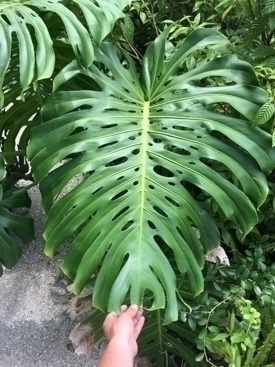
Mature Monstera leaf. Photo C. Johnson
Growing Conditions
Hardy in zones 10a-12b, Mmonstera is native to Mexico and Panama, but is found globally in tropic and subtropical regions. It lends itself to indoor cultivation and is one of the world’s most common houseplants.
Planting Instructions
Monstera roots aggressively both in soil and aerially. Because of this growth habit, vines with established aerial roots can be buried within 2-3” of the first leaf node with a high success rate and little risk of rot. However, when potting vine clusters be careful not to bury growing tips as burying them will increase their chances of rotting.
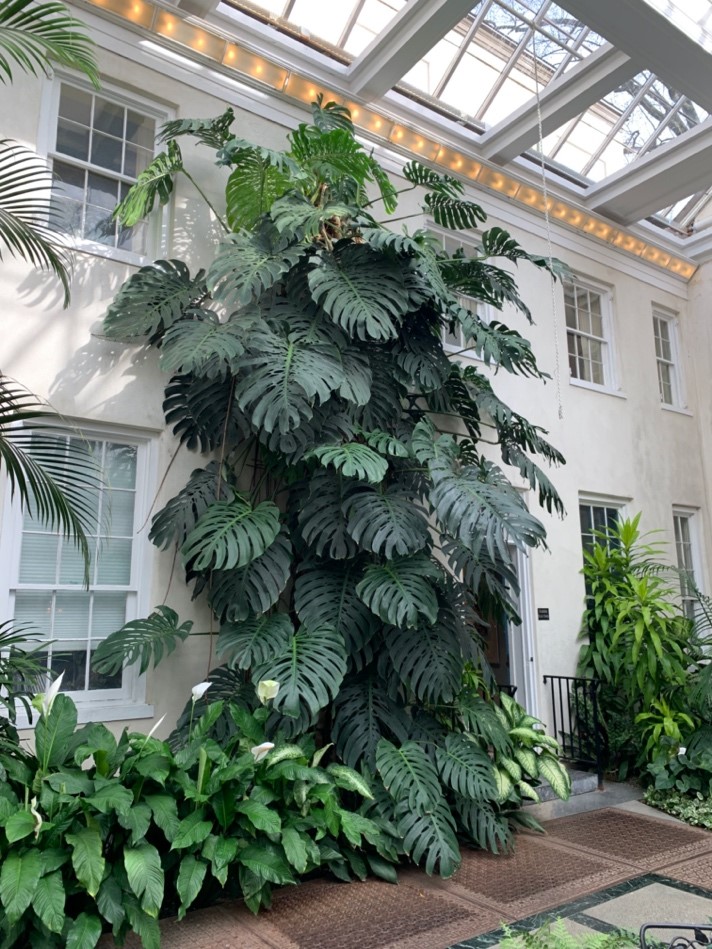
Mature Monstera leaf. Photo C. Johnson
Cultivation
- Soil: A well-draining potting mix with a high organic matter content.
- Watering: Allow top 2-3” of soil to dry between waterings. Monstera is prone to root diseases, especially during colder seasons. A well-draining soil and consistent watering practices will help this risk.
- Light: Monstera prefers partial shade with direct sunlight for 3-6 hours daily. It is important to be vigilant when acclimating this plant to new light levels as its large leaves burn easily.
- Temperature: The plants can be placed outdoors in a semi sheltered area during summer months in New England as long as temperatures don’t drop below 45 °F. Exposure to colder temperatures for any extended period of time will result in cold damage.
- Fertilizing: Monstera is easily burned by high soil salts, but can tolerate regular fertilization during periods of active growth (May-Sept in New England).
- Staking: As vines begin to grow in length, it is common practice to stake them up with garden stakes or a mount them to a moss pole. Moss poles are often used to mimic the porous, natural surfaces that Monsteras climb in the wild. Once vines have successfully attached, leaf size typically increases drastically.
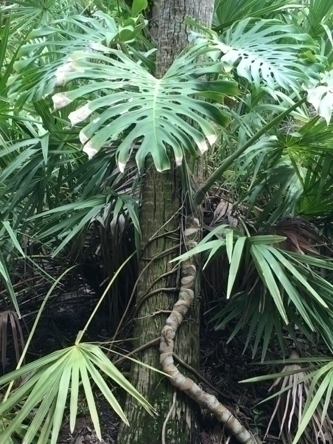
Monstera vine climbing a palm, Mckee Botanical Garden. Photo C. Johnson
Fruit
Monstera is not commonly grown for its fruit in New England, because specimens grown as houseplants do not typically reach the appropriate size or maturity to flower and produce fruit. Monstera flowers are white and showy with a calla-like spadix. Fruit is typically 12” or more, with a plated green covering that turns beige and fleshy when ripe. Fruit is poisonous to humans until completely ripe, which takes approximately one year. Ripe fruit has an edible flesh with a flavor that is described as a cross between jackfruit (Artocrpus heterophyllus) and pineapple (Ananas comosus).
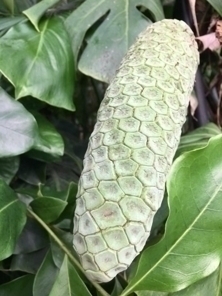
Monstera fruit, unripe. Photo by C. Johnson
Propagation
Monstera can be propagated from stem cuttings, layering, and cane cutting. An ideal stem cutting is taken 3-5” below a node, with as many aerial roots present as possible. Propagation by seed is possible but uncommon as seedlings are slow growing initially and require warm, humid temperatures which are difficult to replicate on a large scale.
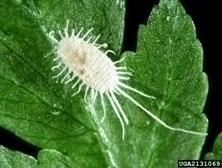
Mealy bug. Photo by David Cappaert, bugwood.org
Common Insect pests
- Mealybugs- A persistent pest of indoor plants, mealybugs can be identified by their white, wax covered bodies which taper to a tail at the end. Eggs are deposited in cottony white masses, which can often be found in plant crevices. Mealybugs feed by sucking plant sap, which can result in yellowing, stunted growth, and in severe cases plant death. Honeydew is produced while feeding which may result in sooty mold. For management, isolate or discard infested plants. Mealybug can be treated with an insecticidal soap that is registered for houseplant use. Insects can be crushed and removed by hand or wiped off using a Q-tip.
Spider mites- These extremely small arachnids can be difficult to spot without a magnifying loupe or hand lens. One of the first signs of a spider mite infestation is the presence of webbing that the mites will use to bridge gaps between plant parts. It is important to note that not all species of spider mites produce webbing. Spider mites use a piercing sucking mouth part to drain chlorophyll from leaves, resulting in fine white spots also called ‘stippling’ on the leaves. Mites can be washed off with water or insecticidal soap. Special attention should be paid to the underside of leaves when controlling spider mites.
- Scale- Soft scale species including brown soft scale and hemispherical scale are very common on house plants. These insects can vary in color but are typically brown to beige and appear as small brown bumps on leaves and stems. Symptoms include stunted growth, yellowing, and honeydew leading to sooty mold. For management, quarantine or discard heavily infested plants. Scale can be treated with horticultural oil or a spray that is registered for houseplant use. Insects can be crushed and removed by hand or wiped off using a Q-tip and alcohol.
- Aphids- Aphids are small (less than 1/8” long), soft-bodied, pear-shaped insects with long legs and antennae. The color can vary from white, yellow, green, red, brown and black. Aphids are the only insect to have cornicles, which resemble two tailpipes on the rear of the abdomen. They have piercing/sucking mouthparts, and feed exclusively on plant sap. They reproduce rapidly to form colonies particularly on new growth. On Mmonstera, new growth is most susceptible because the thick, waxy cuticle of older leaves is less hospitable to aphid damage. Aphids produce large amounts of honeydew resulting in severe sooty mold infestations on leaves. Aphids can be washed off plants with water, insecticidal soap, or a houseplant insecticide. Additionally, there are many biological control products that are available for aphids including parasitic wasps and lady beetles.
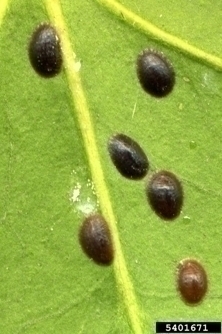
Scale. Photo by Lesley Ingram, bugwood.org
Common Diseases & Disorders
- Bacterial leaf spot-Dark brown spots on leaves with a yellow border. Spots tend to be similar in size, and often exhibit a sticky ooze. Because bacteria are spread by water, dry environmental conditions help slow disease transmission, but may also cause spots to turn reddish brown. For management, avoid low temperatures, overcrowding plants, and increase airflow to reduce humidity. Chemicals are not recommended to manage bacterial leaf spot.
- Anthracnose (Colletoctrichum spp.)- A fungal disease, symptoms start as chlorosis (yellowing) along leaf edges, which progresses to tan and eventually dark brown. These symptoms can spread inward and kill whole leaves. Cankers, or large lesions on stems, may appear as well. For management, avoid misting and wounding leaves as this increases the spread of the pathogen.
- Root & stem rot- Leaves and stems will show noticeable wilt and flagging. Stems can become girdled at soil level by rotting tissue. Affected roots are brown or black with a soft, mushy texture that is easily pulled away from the plant. Correct watering procedures are essential to maintain a healthy root system. Drought stress can cause damage to root tissue leaving it vulnerable to disease, though overwatering is more often the cause of these issues in houseplants. For management, use a well-draining potting media, and ensure plants do not sit in standing water. Adhere to a consistent watering schedule. Repot plants only when roots have reached the bottom and side of the pot, and incrementally increase in pot size. Monstera are much more tolerant of being pot bound than over potted.
For pesticide information or other questions please call toll free: 877-486-6271.
Revised by UConn Home and Garden Education Center 2020.
Issued in furtherance of Cooperative Extension work, Acts of May 8 and June 30, 1914, in cooperation with the U.S. Department of Agriculture, the Dean of the College, Cooperative Extension System, University of Connecticut, Storrs. The Connecticut Cooperative Extension System is an equal opportunity employer and program provider. To file a complaint of discrimination, write USDA, Director, Office of Civil Rights, Room 326-W, Whitten Building, Stop Code 9410, 1400 Independence Avenue, SW, Washington, DC 20250-9410 or call (202) 720-5964